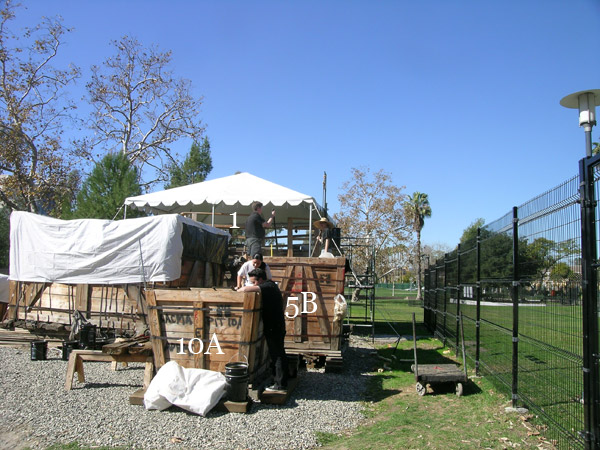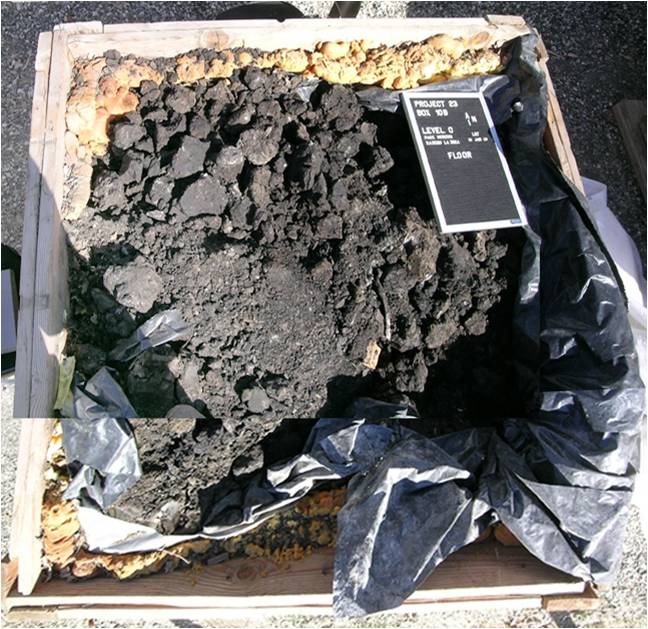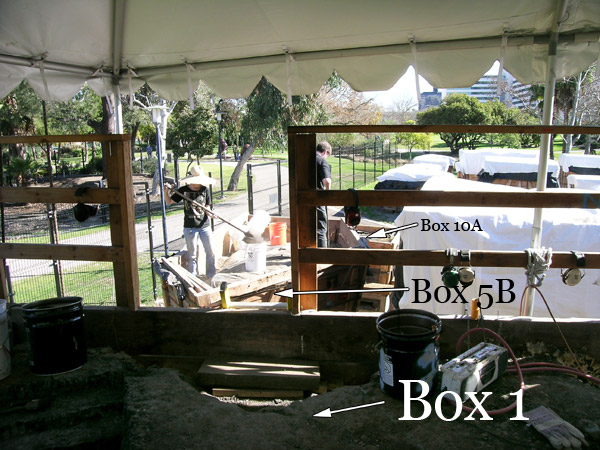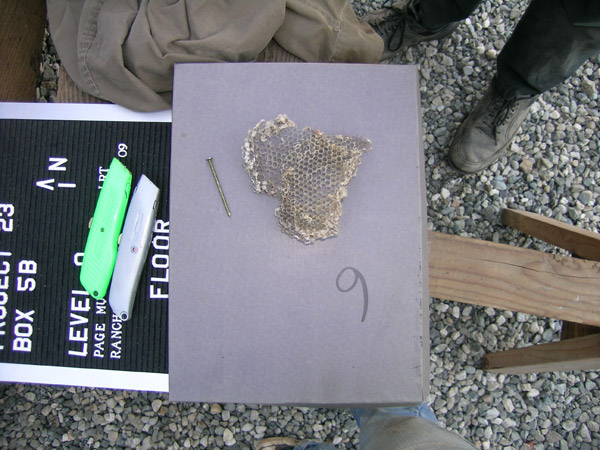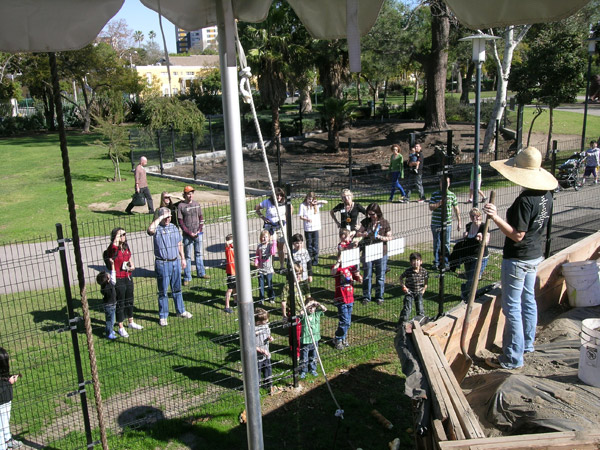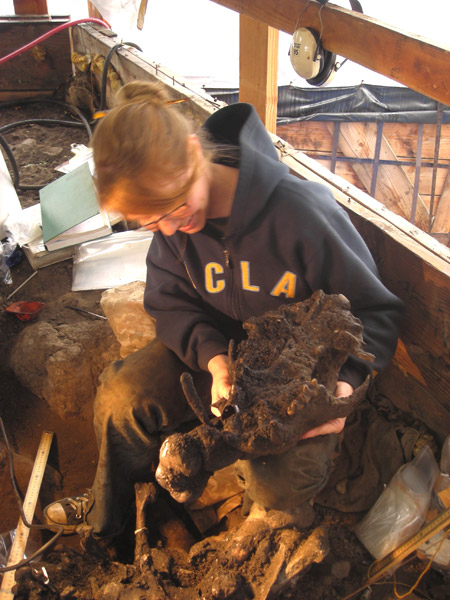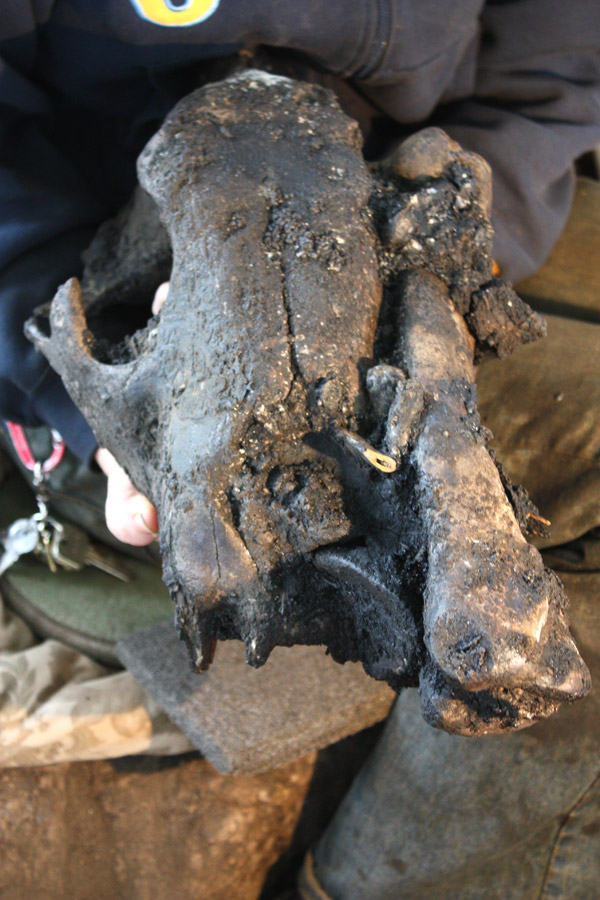
Inspired by our friend Jack Tseng's "What is this?" post, I've decided to place here a mystery bone and you all have to guess what it is. The winner will receive a short on-site tour of the Project 23 excavation site, or, if you are a Page Museum volunteer and have no prior knowledge of what it is, you will win a hearty handshake from the LME (Lone Male Excavator).
I want a specific answer, should be two parts: what bone is it? & what species (or I'll take family) is it?
Ideally, you should also say whether it is a right or a left and what developmental stage it is in (roughly how old was the animal).
21 February 2009
Note from the Lone Male Excavator:
20 February 2009
weekly update: back to basics
It has been one heck of a week here at Rancho La Brea; we were on almost every local news channel, the LA Times, the NY Times, the Brisbane Times, and even a couple papers from Norway ("We can not so many of these, such as deer to tigers sword" indeed!). In light of this newfound limelight (and in light of the exponential increase of blog subscribers!) I want to take a minute to get back to basics.
So for those just joining us: I'm Andie, and I work here, along with lead excavator Kristen Brown, fellow full-time excavator and lone male Ryan Long, and part-time excavators Michelle Tabencki and Laura Tewksbury. Project 23's intial beginnings are described in this blog post and many others found on this site. To date, we've excavated at least 700 fossils (and calculated a minimum number of individual animals of at least 2 dozen). Current tally includes at least:
-3 saber-tooth cats
-1 lynx
-1 North American lion
-6 dire wolves
-2 coyotes
-1 Harlan's Ground Sloth
-1 baby bison
-1 baby horse
-2 dwarf pronghorns
-LOTS of turtle
-at least 5 birds (including a teratorn!)
-LOTS of millipedes
-LOTS of oak leaves
and much much more
And our excavation site currently looks like this:
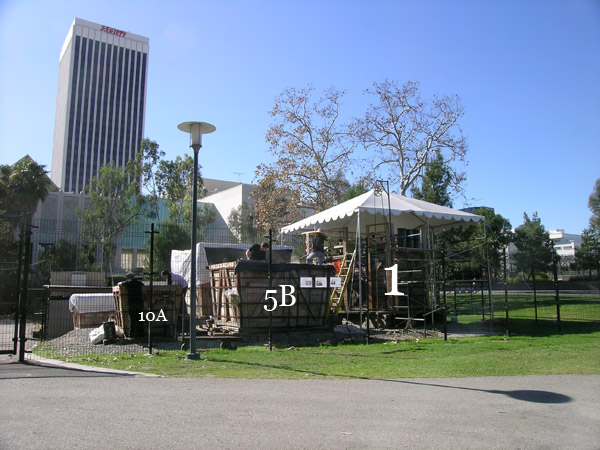
If anyone reading this works in the Variety building, we really want to take pictures from your rooftop...
Deposit 10A (more lifeboat sized...) is also being actively worked on.
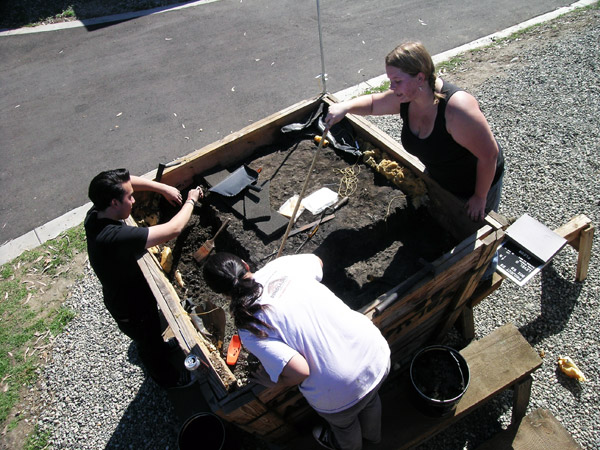
looks like Laura found a fossilized meter stick!
It hasn't yielded nearly as many fossils as Deposit 1, but did give us an interesting piece of turtle which might be new to Rancho La Brea, so that's pretty nifty.
...like this NOT FOSSIL wasp nest. It was on the side of the box under the tarp (again, NOT A FOSSIL). A neat instance of modern life co-existing (well, until the nest was abandoned..) with the extinct.
We continue to excavate 7 days a week (except for bank holidays and whatnot) and will happily talk to you if you stop by, provided we are not lunching, operating heavy machinery, or performing particularly delicate fossil extractions, and you do not try to throw things or yell rude questions (i.e. "Did you find my lost contact yet? Hyuk hyuk hyuk.") at us. We love our jobs, and love sharing our discoveries with you, and THANK YOU for your continued interest and support of natural sciences in general, and Project 23 in particular!
Additionally, there have been a number of questions posted as blog comments over the past week, which we'll answer ASAP. But as for now, we have some serious digging to do.
17 February 2009
In the news (again!)
Hey Angelenos -- Project 23 will be featured on the front page of the LA Times tomorrow! And be sure to check out their online photo gallery as well. And...
Hey early risers -- Project 23 will be on Good Morning, America tomorrow morning! We'll be popping up in all sorts of news outlets this week, so keep an eye out for more.
08 February 2009
In the news
Part-time excavatrix Laura Tewksbury has been busy! She sends us this link:
Whale Fossil for Concordia Elementary School
and writes:
"This was the first fossil preparation project I ever worked on, under paleontologist Greg Seymour. During high school, my mom would drive me over to volunteer at least once a week, and I got to both chip away at his (horrible, fine-grained, concrete-like) matrix and help teach the kids about paleontology. It's pretty much one of the main reasons I'm here [i.e. at Rancho La Brea]. I originally got involved through Dave Gerhard when he first moved to Concordia, since that was my old elementary school, my little sisters were still there, and my mom was PTA President.
How time flies. Like a whale on a hoist. "
Very cool, Laura!
06 February 2009
update: PROGRESS
Remember this?
That, paleo-friends, is the skull of a North American Lion -- Panthera atrox. We finally finished removing all the bones around it, and thus successfully excavated the skull!
But first, here are some interesting inferences about North American Lions, provided by our fair leader, collections manager Christopher A Shaw:
- North American Lions showed up in their eponymous continent (North America) around 400k years ago
- They were probably not social animals -- in other words, there were no prides of these particular lions. We think this for two reasons:
- We don't find nearly as many of them as we do dire wolves and sabertooth cats, and not with nearly the same range of ontogenetic age. For example, we've found approximately 6 North American Lions in Pit 91, compared to around 50 Saber-toothed Cats.
- In a pride of African lions, the ratio of males to females is 1:6 or 1:7. Here at Rancho La Brea the ratio is about 1:1. Thus: no African Lion-esque prides. North American Lions likely had a more solitary lifestyle, more akin to that of a mountain lion.
Back to our skull: after months of carefully using dental picks to clear out the surrounding matrix, we eventually had to resort to brute force to get the lion skull out.
That's me on the left, Michelle on the right. I'm rocking the skull back and forth on its side to loosen it from the surrounding matrix; Michelle is holding on to a bone underneath the skull to keep it from coming out along with the lion. Aisling wisely thought to film the entire process:
Background soundtrack provided by: Marketplace with Kai Ryssdal on NPR; Laura Tewksbury singing; various lab volunteers cheering; and me saying "there's a frickin humerus attached to it!" A great orator, I am not...
Though quality on this video isn't the best, it is good enough to show just how tough it is to get something out of an asphaltic deposit. Even after putting all of my weight behind the skull, at first it barely moves. However, after some artful wiggling (and a decent amount of luck) it's out!
The skull itself is an absolutely beautiful specimen; it's the most complete P. atrox skull we've gotten out of the current excavations (i.e. Pit 91 and Project 23).
Look at all those bones I could have damaged had I continued using a dental pick! The crescent shaped bone in the lion's mouth is a horse hoof; there's a complete saber cat rib in the back; and yes, on the right -- there's a fricken humerus attached to it. Sabertoothed cat humerus, to be exact.
And now that the skull's out, we can get on with our excavation.
These are just a few of the bones that are now accessible thanks to the skull's removal. Click the picture above to be taken to our flickr site, where you can mouse-over individual bones and find out what they are.
As for our skull...
Laura promptly carried it off to the lab, and rumor has it that Herb will begin cleaning it in a few weeks. We think we'll name it Fluffy.
